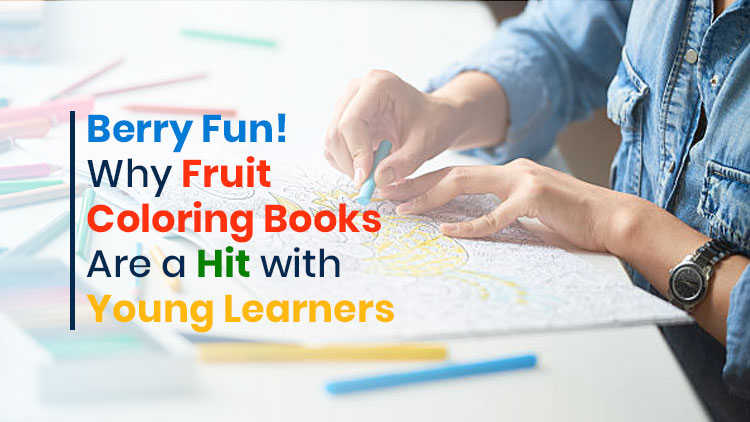
Berry Fun! Why Fruit Coloring Books Are a Hit with Young Learners

Berry Fun! Why Fruit Coloring Books Are a Hit with Young Learners
Introduction
Coloring books have long stood the test of time as trusted educational tools that spark creativity, build fine motor skills, and enhance cognitive development in young learners. While the themes of these books have evolved, ranging from animals to alphabets to space adventures, fruit-themed coloring books have carved out a vibrant niche of their own in recent years.
But what exactly sets fruit-themed coloring books apart? Are they simply visually appealing, or do they offer deeper developmental value for early learners? In this post, we explore the unique benefits of fruit-themed coloring books, how they promote learning through play, introduce healthy habits, and foster early recognition skills in a fun, engaging way.
At VERSAtile Reads, we’re passionate about blending creativity with education. Our expert-designed coloring books and learning resources support parents, teachers, and caregivers in raising confident, curious learners. Explore our coloring collection that transform everyday moments into meaningful learning experiences.
The Magnetic Appeal of Fruit Coloring Books
Young children are naturally drawn to bright, colorful images. Fruits, with their vivid hues and simple shapes, naturally attract attention and spark curiosity. Unlike abstract or complex themes, fruit coloring books feature objects that children encounter regularly, whether at home, grocery stores, or school.
This familiarity breaks down intimidation and makes the activity accessible. The fearless boundaries and simple shapes create attention and facilitate concentration, allowing children to excel and thrive. This success builds confidence. This encouragement inspires them to connect further with the coloring process.
Additionally, fruit coloring books bridge the gap between fun and education. The simple act of coloring apples, oranges, bananas, and berries opens doors to discussions about health, nature, and science, making learning multidimensional and interactive.
How Fruit Coloring Books Boost Key Developmental Skills
1. Fine Motor Skill Development — The Foundation for Future Learning
Fine motor skills, the capacity to execute small movements using fingers and hands, play an important role in early childhood development. Holding crayons, regulating strokes, and staying inside the lines all aid in dexterity and hand-eye coordination.
Fruit coloring books are particularly ideal for building these skills. The curved and discrete forms of fruits offer reasonable challenges which lead children to repeatedly practice precise movements. This builds up the muscles necessary for writing, drawing, and using tools over time.
For instance, a child who is coloring a strawberry will have to pay close attention to the curvaceous edges, developing control and patience. The repetitive exercise is fun but serves as an effective precursor to formal writing activities.
2. Healthy Habits and Nutrition Awareness
Establishing healthy eating ideas at an early age can have long-term effects. Fruit coloring books are gentle, yet powerful, mechanisms to sensitize children to wholesome foods.
As children color, they tend to identify familiar fruits and recognize these foods when they encounter them in everyday life. Parents and teachers can expand on this identification by reading or talking about the advantages of fruits, including vitamins, fiber, and energy, during or after coloring.
For example, a coloring activity on citrus fruits can accompany a lesson on vitamin C and how it contributes to maintaining a healthy immune system. Conversations like these make plain coloring into healthy lessons about wellness.
3. Vocabulary Building and Language Ability
Coloring books on fruits also help in language development. While children recognize and identify various fruits, colors, and forms, their vocabulary is increased contextually.
Teachers and caregivers can inspire children to name the fruits they color, talk about textures (such as smooth apples or lumpy oranges), or even fruit names in other languages and cultures, promoting multicultural understanding.
This word-image connection activity enhances early literacy, improves understanding, and aids verbal communication.
4. Creativity and Imaginative Expression
Though fruits do have familiar colors, coloring books of fruits allow children to go outside the box with color choices. Children may color blueberries purple or bananas blue, using their own sense of vision.
This creativity allows for freedom and the development of confidence. Art is presented to children as subjective and personal, and they get to discover themselves without fear of making mistakes.
Additionally, this play enhances cognitive flexibility, the capacity to generalize and think outside the box, an important ability for problem-solving and innovation in adult life.
What Makes Fruit Coloring Books Stand Out?
Several qualities give fruit coloring books an edge over other popular themes such as animals, vehicles, or fantasy characters:
- Everyday Relevance: Fruits are commonly found in children’s environments, making them easy to relate to and understand.
- Interdisciplinary Learning: Fruit images provide entry points into science (biology, nutrition), culture (food traditions), and art (color theory).
- Simplicity with Depth: Clear shapes make coloring accessible for beginners, while detailed designs engage older children.
- Color Variety: Fruits come in an expansive range of bright and attractive colors that naturally entice children to explore coloring.
- Positive Associations: Emphasizing healthy foods subtly promotes good dietary habits in a fun, pressure-free manner.
These factors combine to make fruit coloring books versatile, educational, and enjoyable.
Tips for Parents and Educators to Maximize Benefits
To leverage the full potential of fruit coloring books, parents and educators can:
- Make Storytelling a Part of Coloring: Create stories around fruits, for example, a day in the life of a strawberry, to spark imagination and language skills.
- Connect with Real-Life Experiences: After coloring a fruit, offer a tasting session or a trip to a farmer’s market to explore sensory learning.
- Integrate into Thematic Lessons: Use fruit coloring as part of broader lessons on plant life cycles, seasons, or cultural food practices.
- Experiment with Different Art Materials: Introduce watercolor paints, colored pencils, or stickers to enhance tactile engagement.
- Celebrate Achievements: Display completed artworks at home or in class to build pride and social skills.
Embracing Technology: Digital Fruit Coloring Apps
The rise of educational technology has introduced digital fruit coloring apps, blending traditional learning with interactive media. These apps often feature animations, sounds, and immediate feedback, providing engaging experiences that captivate tech-savvy children.
When used thoughtfully and balanced with physical activities, digital coloring tools can complement traditional books by offering additional layers of stimulation and accessibility.
Conclusion
Fruit coloring books are more than just simple pastimes. They are dynamic learning tools that combine creativity, education, and development in ways that resonate deeply with young learners. Their bright imagery, real-world connections, and broad benefits make them a popular choice among parents and educators aiming to nurture well-rounded growth.
By supporting fine motor skills, encouraging healthy eating habits, enhancing vocabulary, and fostering creativity, fruit coloring books align seamlessly with modern early childhood education principles.
FAQs
Q1: What age is best suited for fruit coloring books?
Fruit coloring books are ideal for children ages 3 to 7 years. This period is critical for developing fine motor skills, early language, and foundational cognitive abilities.
Q2: Can fruit coloring books encourage children to try new fruits?
Yes, repeated exposure through coloring and conversation helps children become familiar and comfortable with fruits, increasing the likelihood they will try new ones.
Q3: Are digital fruit coloring books as effective as physical ones?
Both have unique advantages. Physical books help develop tactile skills and reduce screen time, while digital apps offer interactive engagement and easy accessibility. Combining both can provide balanced learning experiences.
- Published Date:



